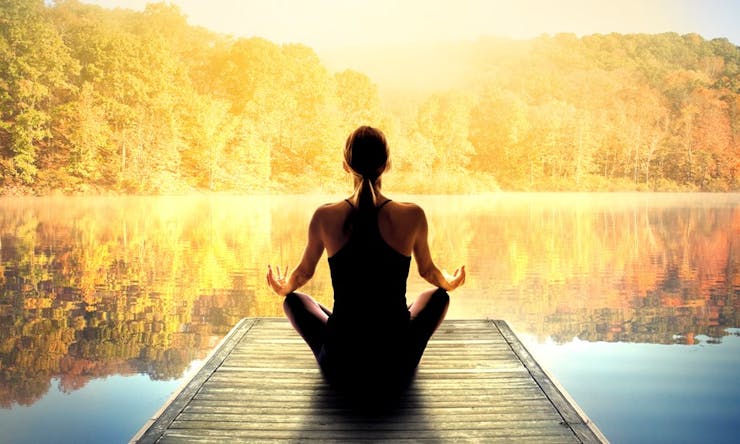While often considered a method of relaxation, smoking is not traditionally considered an act of meditation. However, many meditations share a core principle that has a lot in common with the way one smokes – and it’s all about the breath.
The rhythm of smoking is mostly universal – deep breath in, pause, long slow exhale out. A novice may expel the smoke quickly and violently, perhaps erupting into a coughing fit, but the seasoned smoker has gained control over the momentum of their breath on the exhale.
Similarly, someone experienced with meditative breathing will practice in a way that closely mirrors this pattern. In fact, one could go so far as to say that smokers have a head start in learning and successfully practicing the art of pranayama, or meditative breathing. This is good news as pranayama is an excellent way to improve one’s physical and mental health.
In The Complete Yoga Book, James Hewitt writes:
“It can be seen that breathing exercises act as a substitute for smoking: air is inhaled, retained, and exhaled, but it is fresh pure air in place of poisonous air that destroys health. And Yogic breathing, and Yogic practice in general, is more successful than smoking cigarettes in combating restlessness and taut nerves.”
Hewitt speaks specifically and directly to tobacco smokers in this excerpt, but his observation about the similarity between breathing meditation and smoking can be generalized. One may even say that cannabis smokers have an upper hand due to having greater lung capacity and health than tobacco smokers. This means there will not be the same breathing obstacles when practicing pranayama that cigarette smokers may face.
How is Meditative Breathing Done?

Traditionally, when thinking of breathing, one thinks of two simple steps: inhale and exhale. The act of pranayama, however, is comprised of four steps: inhale, pause, exhale, pause, while breathing at all times through the nose, not the mouth. Inhalation should be unbroken and steady; one long smooth movement. At the top of the breath, when one’s lungs are comfortably full, the first pause begins. What follows is the exhalation, and then another pause.
It’s very important to remember that meditative breathing should always be comfortable. There’s no gain in filling one’s lungs with extra air to a point that causes strain. No additional benefit will be gleaned from this exaggerated effort, and in fact it will only serve to hinder the physical and mental benefits that are otherwise available. The same must be understood for the length of time in holding a breath – comfort should be a top priority.
As in all aspects of yoga, competition has no place, respecting and understanding personal boundaries and limits is essential to mastering any technique.
There exist several breathing ratios, but for beginners, the focus should be on a ratio of 1:1:2:1. Time can be counted in several ways, the easiest being a silent “one-one-thousand,” “two-one-thousand,” “three-one-thousand.”
For the first inhale a silent count of “one-one-thousand” should be recited, followed by a second count of “two-one-thousand” as one pauses at the top of the inhale. In the next step, the exhale should be twice as long, slow, steady, and even. “Three-one-thousand, four-one-thousand” should be silently counted during the exhalation.
Shop highly rated dispensaries near you
Showing you dispensaries nearYogic practice explains that the reason for the extended exhalation is to allow the body to maximize the expulsion of old air in the lungs, clearing out the air sacs to make room for fresh new vital air. As mentioned, just as with smoking, one should not allow the air to burst forth in a sudden expulsion, but instead be let out with control and ease.
At the bottom of the exhale, with lungs comfortably empty, the second pause begins, lasting one second.
For smokers, this exercise will likely feel very familiar – and it is in this way that smoking mirrors pranayama so closely. Though lacking the exact ratio, the basic premise is very similar, while the need for control and steadiness of breath is familiar.
Efficient Breathing Factors

This ratio is the basic premise of pranayama, but there are other key concepts one must know to create a practice that is as efficient and beneficial as possible. One such factor that should be considered is setting and posture.
It is recommended that pranayama be practiced in a quiet space at a comfortable temperature, whether that be inside or outdoors. One should be relaxed, comfortable, and at ease. The next important step is to be aware of proper posture. It is recommended that one sit cross-legged on the ground; however, for those who have physical limitations that prevent such, sitting upright in a chair is another option.
Be sure to sit up straight, creating one even line from the crown of the head to the abdomen. By creating this open space, air is able to move through the body more effectively and easily. Once the environment and posturing is correct, the breathing exercises can begin.
The Benefits of Pranayama

So why should one opt for practicing pranayama at all, and who is it appropriate for?
Breathing meditations are suitable for people of all ages and lifestyles, but long, extended pauses in breath should be avoided by those with high blood pressure or heart, lung, ear, or eye conditions. Beginners will benefit from practicing for 15 minutes per day, or 10 minutes per day in two separate intervals (such as once in the morning and once at night).
The primary benefit of pranayama practice is a restoration of mind that ultimately positively affects one’s physical wellbeing by calming the nervous system, exercising the lungs, and moving optimal oxygen through the body.
Consider the way breathing naturally coincides with one’s mental state – a person who is distressed may have short, shallow breaths, perhaps even hyperventilating. However, a person who is deep in thought, one who listens intently or feels very calm, will generally take long, slow, and deep breaths.
In the same way, practicing pranayama with clean, fresh air will leave one feeling energized, tranquil, and bestowed with greater peace of mind. For cannabis smokers who have already mastered aspects of the breathing technique, this means a beneficial meditation is only a few breaths away.










